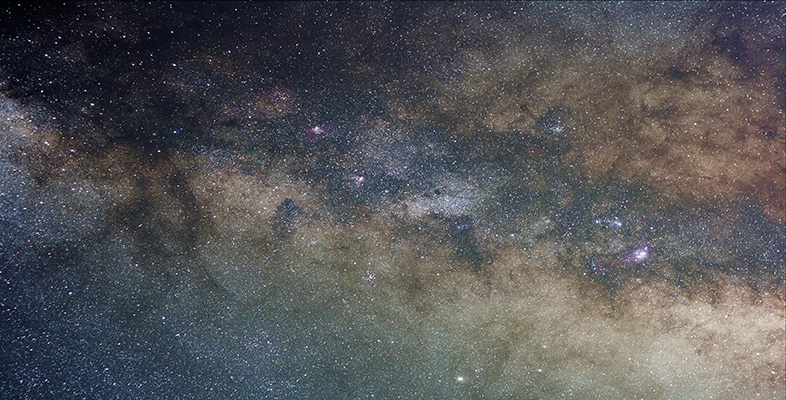3.3 Quasars
One of the most unexpected turns in the history of astronomy was the discovery of quasars. When first recognised, in 1963, quasars appeared at radio and optical wavelengths as faint, point-like objects with unusual optical emission spectra. The name comes from their alternative designations of 'quasi-stellar radio source' (QSR) or 'quasi-stellar object' (QSO), meaning that they resemble stars in their point-like appearance. Their spectra, however, are quite unlike those of stars. The emission lines turn out to be those of hydrogen and other elements that occur in astronomical sources, but they are significantly red-shifted.
Figure 15 shows the optical spectrum of 3C 273, which was the first quasar to be discovered (you have already seen its broadband spectrum in Figure 10). The redshift is 0.158, which corresponds to a distance of about 660 Mpc according to Hubble's law. Many other quasars are now known - a recent catalogue lists more than 7000 - and the vast majority have even greater redshifts, the record (in 2003) being more than 6. All quasars must therefore be highly luminous to be seen by us at all.
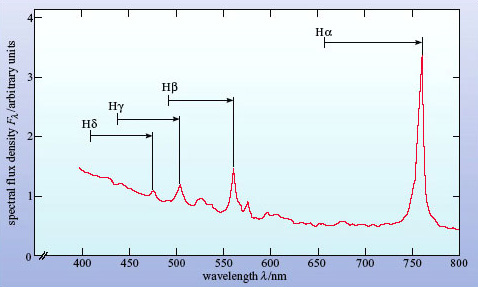
The optical spectra of quasars are similar to those of Seyfert 1 galaxies, with prominent broad lines but rather weaker narrow lines. A composite spectrum for 700 quasars is shown in Figure 16. To form this spectrum, the individual quasar spectra were all corrected to remove the effect of red-shift before being added together. Because many quasars have high redshifts, many of the features that are observed in the visible part of the spectrum correspond to emission features in the ultraviolet. In particular, the spectrum shows the Lyman ![]() (Ly
(Ly![]() ) line that arises from the electronic transition in atomic hydrogen from the state n = 2 to n = 1. This line, which occurs at a wavelength of 121.6 nm, is clearly a very strong and broad line in quasar spectra.
) line that arises from the electronic transition in atomic hydrogen from the state n = 2 to n = 1. This line, which occurs at a wavelength of 121.6 nm, is clearly a very strong and broad line in quasar spectra.
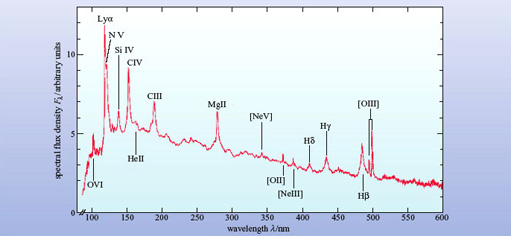
Quasars show spectral excesses in the infrared and at other wavelengths. About 10% of quasars are strong radio sources and are said to be radio loud. Some astronomers prefer to retain the older term QSO (quasi-stellar object) for radio-quiet quasars that are not strong sources of radio waves. The spectral energy distribution for a sample of radio-loud and a sample of radio-quiet quasars is shown in Figure 17. The big blue bump, hinted at in Figure 10, is particularly prominent here. Many quasars are also variable throughout the spectrum on timescales of months or even days.
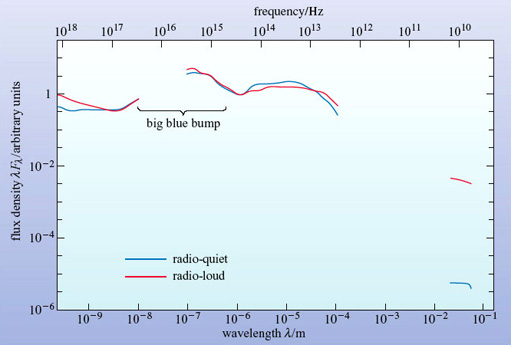
Detailed radio mapping shows that many of the radio-loud quasars have prominent jets which appear to be gushing material into space. In 3C 273 the jet is even visible on optical images (Figure 18).
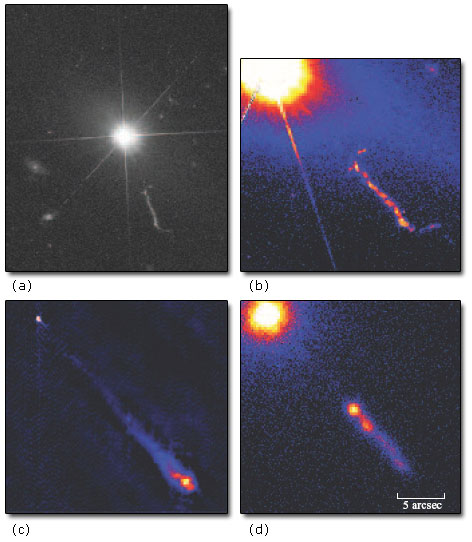
Because quasars are so distant, it has been difficult to study the host galaxies which contain them. Recent work seems to show that there is no simple relationship between a quasar and the morphology of its host galaxy - while many quasar host galaxies are interacting or merging systems, there are also many host galaxies that appear to be normal ellipticals or spirals (Figure 19). It has also been found that the radio-loud quasars tend to be found in elliptical and interacting galaxies whereas the radio-quiet quasars (the QSOs) seem to be present in both elliptical and spiral host galaxies. It should be stressed however that the relationship between quasar host and radio emission is not clear-cut, and that this is a topic of ongoing research.
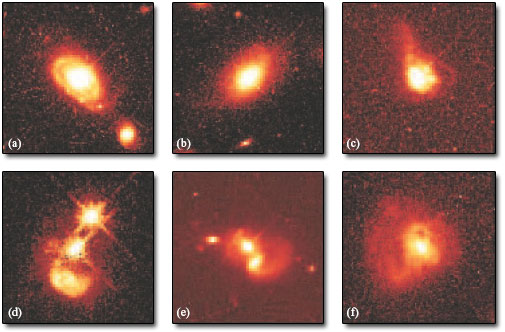
Before their host galaxies were discovered in the 1980s quasars seemed much more puzzling than they do now. Indeed, for many years, there was a school of thought that supported the idea that quasars were not at such great distances as they are now thought to be, but were instead relatively close objects in which the red-shift arose from some unknown physical process. The study of quasar host galaxies has all but dispelled this view and the modern picture of a quasar is of a remote, very luminous AGN buried in a galaxy of normal luminosity. This is why astronomers now regard quasars as a type of active galaxy, though you will still see books referring to 'active galaxies and quasars'. Quasars are believed to be the most luminous examples of AGNs known.
